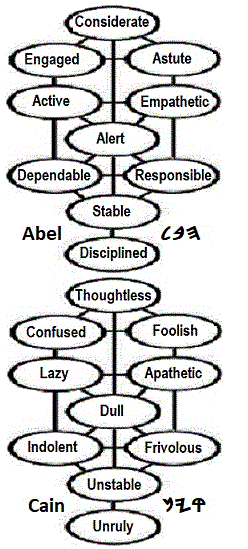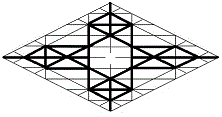The Firmament Within
 Our
true lives are hidden in HaShem. The lives we live in heaven and on
earth are phases of a continuum in which wheels turn within wheels; for
nothing in creation is as it seems.
Our
true lives are hidden in HaShem. The lives we live in heaven and on
earth are phases of a continuum in which wheels turn within wheels; for
nothing in creation is as it seems. The expanse of earth wears its firmament like a crown; for it stretches into the vault of heaven like an immense spiritua aqueduct. It’s a corridor, a wormhole that connects the eternal with its temporal manifestations. Its Name is Yardan: Jordan, the River of Souls.
In concert with the spirit of HaShem, angels travel the spiritual firmament between temporal spheres at the speed of thought. Its column of spirit is as the highway of Ezekiel’s living creatures, within each of which wheels turned within wheels.
Our lives are not linear, but cyclical. We remain at rest in the eternal realm, where our lives are hidden with God, even as we migrate through temporal realms on the path to perfection; and we are transformed within the spirit of HaShem in accordance with our functions, on earth as in heaven.
Before we are born, we are known of the father; we are named, and we are privileged to accept his will in the Kingdom of Names.
A woman shall encompass a man. Beyond salvation, we participate in the perfection of creation. In natural birth, the woman surrounds the child she will deliver when her time comes. In spiritual birth, the woman is the envelope of God’s spirit, within which a Son of Man lives and moves and has his being as he is reshaped in the contours of the celestial realm, in which time shall be no more.
There are twins in the womb on both personal and cosmic scales. The prevailing understanding is that one twin is good; the other, not good. This view lends credence to the notion that one child should be favored at the expense of the hapless child of Hagar, who is all but abandoned in the scorching wilderness of Shur.
The destinies of rival brothers is a subtext of many parables. How is it that none is lost but one, yet many are are called, but few are chosen? The road is long; the faces are many; the relationships are highly complex, their histories convoluted. I find the hint of an answer in the father’s words to Cain, “If you do well, shall you not be accepted?”
 Brothers
are for adversity. By the will of HaShem, struggling twins must both
come to birth; for they are faces of the same 68 being. The prayer is
that all called out of the world be one. Twins are like the poles of a
magnet. When a fire worm incarnates, it does not cease to exist in
heaven, nor does it leave heaven, entirely. Rather, the caterpillar
inches forward and settles with one foot coming to earth, while others
remain in heaven. It parts the hoof.
Brothers
are for adversity. By the will of HaShem, struggling twins must both
come to birth; for they are faces of the same 68 being. The prayer is
that all called out of the world be one. Twins are like the poles of a
magnet. When a fire worm incarnates, it does not cease to exist in
heaven, nor does it leave heaven, entirely. Rather, the caterpillar
inches forward and settles with one foot coming to earth, while others
remain in heaven. It parts the hoof. Manifestations in the universe are paired, and HaShem sends his emissaries out by twos, even as Joshua sent spies into Canaan by twos. As brothers scuffle within time, one twin shuffles ahead or falls behind, but both are in the lineage of the Son of Man.
Would not righteous Abel mourn the loss of his troubled brother? They are faces of the same being. It's written, “Learn what this means, ‘I will have mercy, not sacrifice.’” We can’t hate the offender and understand God’s righteousness. Works can be disavowed, but one can no more lawfully hate himself than he can hate brothers or sisters, all of whom we are to love as ourselves.
Self hatred is the exercise of accusation and condemnation, not denial of self. Both the “not good” and the “good” must be denied, so that that which is pure may be manifested. The word of HaShem to the apostle Peter is, “Do not call anything impure that God has made clean.” The wall of partition is broken down.
What good does any earn by being thankful for the good things HaShem provides? The father is no doubt pleased that we are pleased, but the hardships he sends our way are also important markers of delayed blessings that will surely come.
Trials alert us to need, and they drive our search for remedy. If, as we see it, the way forward is blocked, it is better that we begin a dialog about reasons than for us to ask for specific solutions. To see an enemy or a fault or a need is to imply that HaShem is less than gracious.
If we would enjoy true fellowship with the father, we should receive him as a friend. If our communications with HaShem are rooted in love, we will find ourselves losing enemy after enemy in the world of men as we labor in the Kingdom of Names.
We earn freedom for ourselves and for our brethren within the comfort of messiah’s embrace. It is not because of anything within us or for things that fall before us that we know ourselves to be disciples of the Son of Man. We are friends of the anointed messiah because we share the father’s love.
What, then, is explanation for the confusion about left and right, good and evil, positive and negative, sinner and saint? It’s the mistaken idea that creation is filled with dichotomies, with good and evil chief among them.
Good is an absolute. Its opposite would be wickedness, an utter absence of goodness. In the days of creation, HaShem beheld only the good and the very good; and in the days of Moses, the prophet was given laws that were good and laws that are not good. Wickedness is not named, and evil is not mentioned. Good is defined here, and evil is also defined here, but it is elsewhere.
Only YHWH is good, and only the Son of Perdition is beyond redemption. The creation is the display of order within nominally incompatible elements. Isaiah wrote at some length to warn us that, insofar as good and evil are concerned, we’ve got a lot to learn.
This mystery is understood in the parable of the fig that was so evil that none could eat it. Was it a little immature? A little overripe? No, the fig was, plainly, garbage. Evil is every gradient of error that lies between the spirit of HaShem and its theoretical opposite.
 The
emanation of HaShem remains rooted in the eternal as it is projected
into the temporal. In like manner, the angels of heaven remain rooted in
the immortal as they put on mortal garments for life on temporal earth.
The
emanation of HaShem remains rooted in the eternal as it is projected
into the temporal. In like manner, the angels of heaven remain rooted in
the immortal as they put on mortal garments for life on temporal earth.
Similarly, the physical body and the mortal soul of the natural man remain rooted on earth, but they also retain a presence in heaven. Immortal, mortal, or everlasting, life remains hidden with HaShem in the eternal.